Resilient Flooring Market Size
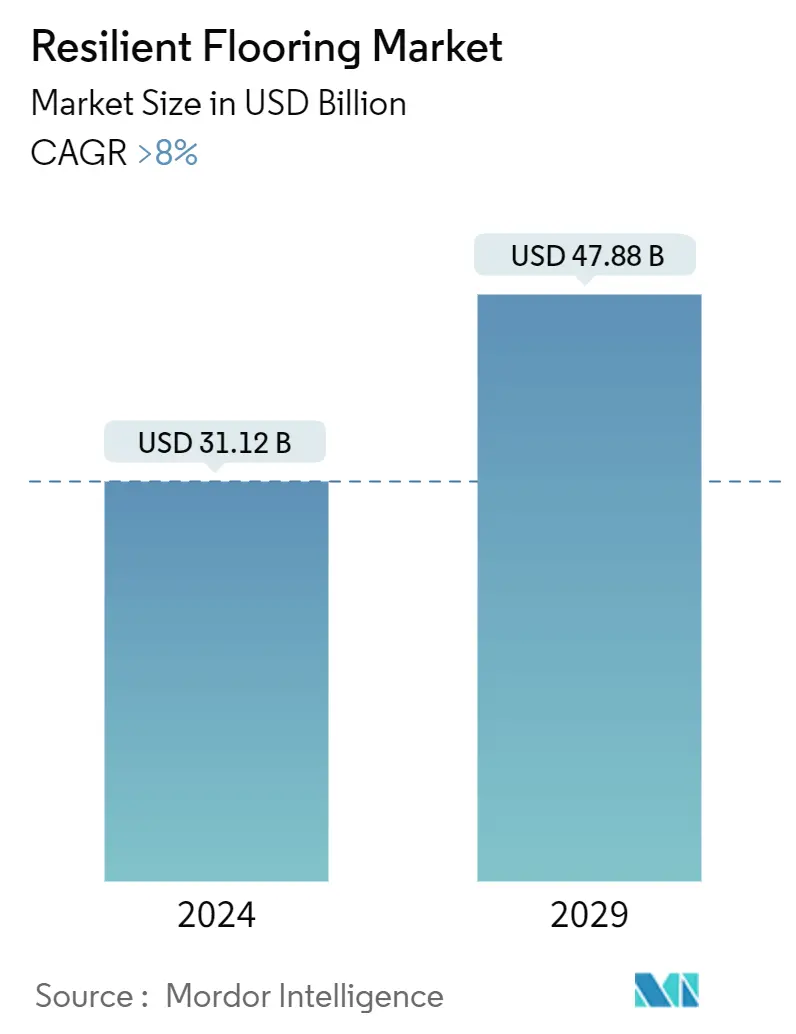
| Study Period | 2019 - 2029 |
| Market Size (2024) | USD 31.12 Billion |
| Market Size (2029) | USD 47.88 Billion |
| CAGR (2024 - 2029) | 8.00 % |
| Fastest Growing Market | Asia Pacific |
| Largest Market | Asia Pacific |
Major Players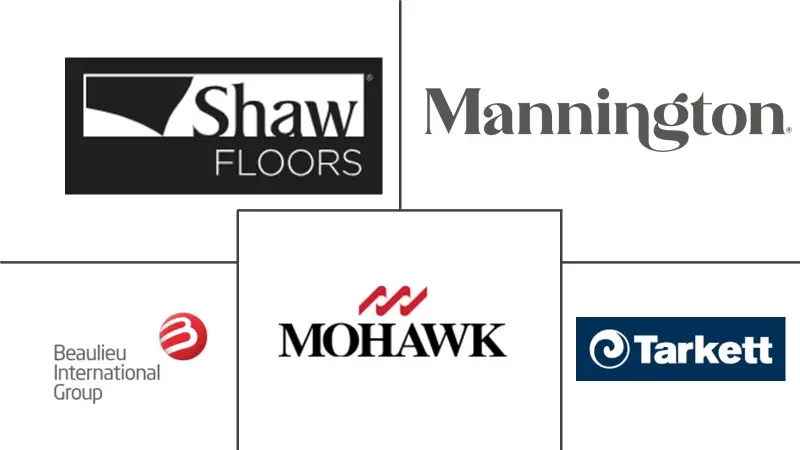
*Disclaimer: Major Players sorted in no particular order |
Resilient Flooring Market Analysis
The Resilient Flooring Market size is estimated at USD 31.12 billion in 2024, and is expected to reach USD 47.88 billion by 2029, growing at a CAGR of greater than 8% during the forecast period (2024-2029).
The COVID-19 pandemic had negatively impacted the resilient flooring market. The nationwide lockdowns and strict social distancing measures had resulted in a halt in residential and commercial construction activities across the globe, thereby affecting the market for resilient flooring. However, post-COVID pandemic, the market recovered well after the restrictions were lifted. The market recovered significantly, owing to the increasing commercial and residential construction activities across the world.
The increasing application of resilient flooring at commercial places and the increasing demand for luxury vinyl resilient flooring are expected to drive the market for resilient flooring.
The increasing concern over environmental impact during the manufacturing of flooring materials and the availability of other flooring products are expected to hinder the market's growth.
The increasing innovations in resilient flooring are expected to create opportunities for the market during the forecast period.
The Asia-Pacific region represents the largest market and is also expected to be the fastest-growing market over the forecast period, owing to the increasing consumption from countries such as China, India, and Japan.
Resilient Flooring Market Trends
Residential Application Segment to Dominate the Market
- The resilient flooring system is denser and non-absorbent and ensures a pliant surface that makes walking comfortable. Additionally, resilient flooring also ensures less maintenance than other flooring. Thus, the demand for resilient flooring is increasing in residential buildings.
- Resilient flooring is a lot cheaper than non-resilient, and its comparably durable nature makes it a relatively cost-effective option for residential homes and commercial buildings. The increasing focus on customization in the flooring of residential buildings and manufacturing processes had a significant impact on the growing demand for resilient flooring from residential building construction.
- The Asia-Pacific and North America are the most significant regions for residential construction globally. In North America, residential construction activities are increasing in countries like the United States and Canada, which are driving the market for resilient flooring. According to the US Census Bureau, the annual value of residential construction output in the United States was valued at USD 908 billion in 2022, compared to USD 802 billion in 2021.
- Similarly, in Canada, new residential construction projects are expected to drive the country's market for resilient flooring. The number of new housing starts in Canada is registered at 64,042 units in Q2, 2023, compared to 46,851 units started in Q1, 2023.
- Similarly, in Europe, residential construction activities are increasing. Germany is the largest market for residential construction in the region. The country's construction industry has been growing and is driven by increasing new residential construction activities. For instance, according to Eurostat, the building construction revenue is registered at USD 114 billion in 2022 and is expected to reach USD 125.4 billion by 2024.
- Hence, owing to the factors mentioned above, the residential application segment is expected to dominate the resilient flooring market during the forecast period.
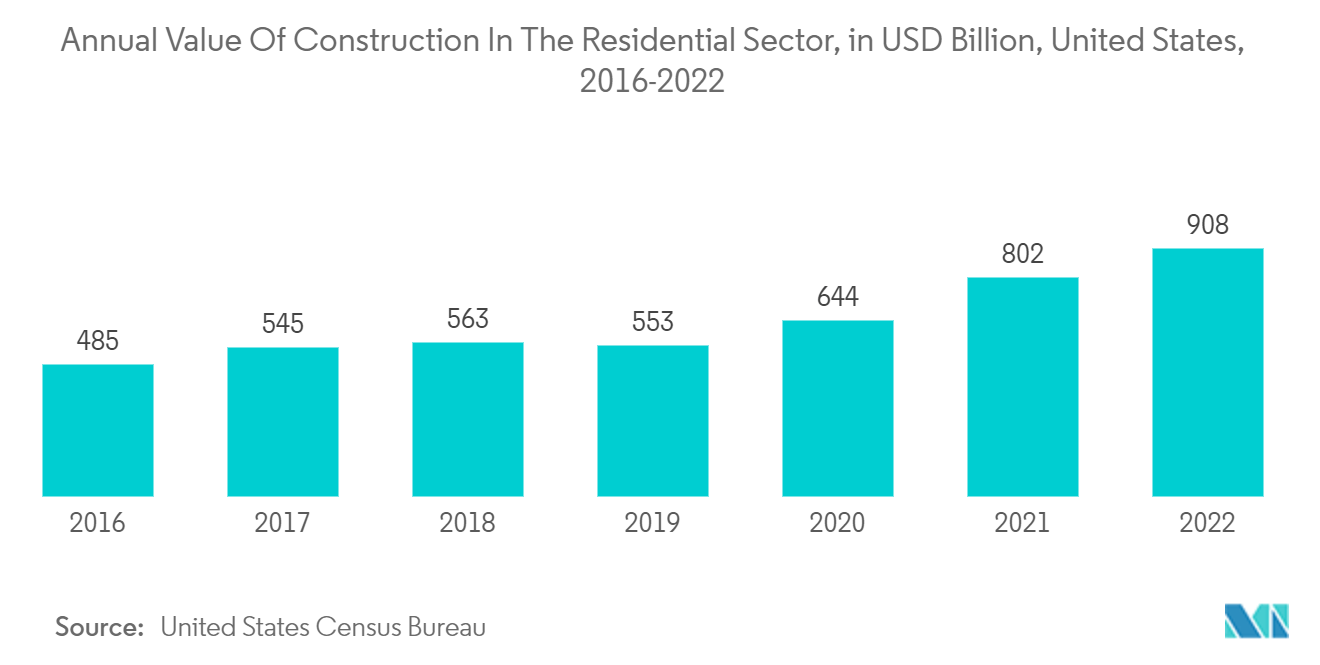
Asia-Pacific Region to Dominate the Market
- The Asia-Pacific region is expected to dominate the resilient flooring market during the forecast period. The rising demand for resilient flooring from residential building construction and growing application in the commercial sector in developing countries like China, Japan, and India is expected to drive the demand for resilient flooring in this region.
- China is one of the largest construction markets in the region. According to the National Bureau of Statistics of China, the value of construction output accounted for CNY 31.2 trillion (USD 4.5 trillion) in 2022, up from CNY 29.3 trillion (USD 4.2 trillion) in 2021. China is expected to spend nearly USD 13 trillion on buildings by 2030.
- Furthermore, the increasing disposable income in the country has triggered the growth of lavish commercial spaces like malls, hotels, offices, etc. China is one of the leading countries in the construction of shopping centers. China has almost 4,000 shopping centers, while 7,000 more are estimated to be open by 2025. Moreover, the construction of office spaces such as Wuhan Fosun Bund Center T1 in China is expected to boost the market studied. Construction work started in Q3 2021 and is forecasted to complete in Q4 2025.
- Similarly, in India, as per the Budget of 2023-2024, a dedicated amount of USD 1,218 million per annum has been allocated through urban infra-development funds for Tier II and Tier III cities. This will result in the creation of quality urban infrastructure. This will also translate to higher demand for housing and commercial construction activities, thereby driving the market for resilient flooring.
- According to Global Construction 2030 (published by Global Construction Perspectives and Oxford Economics), Southeast Asia's construction market is anticipated to exceed USD 1 trillion by 2030, which in turn boosts the demand for resilient flooring in residential building construction.
- Owing to the above-mentioned factors, the market for resilient flooring in the Asia-Pacific region is projected to grow significantly during the study period.
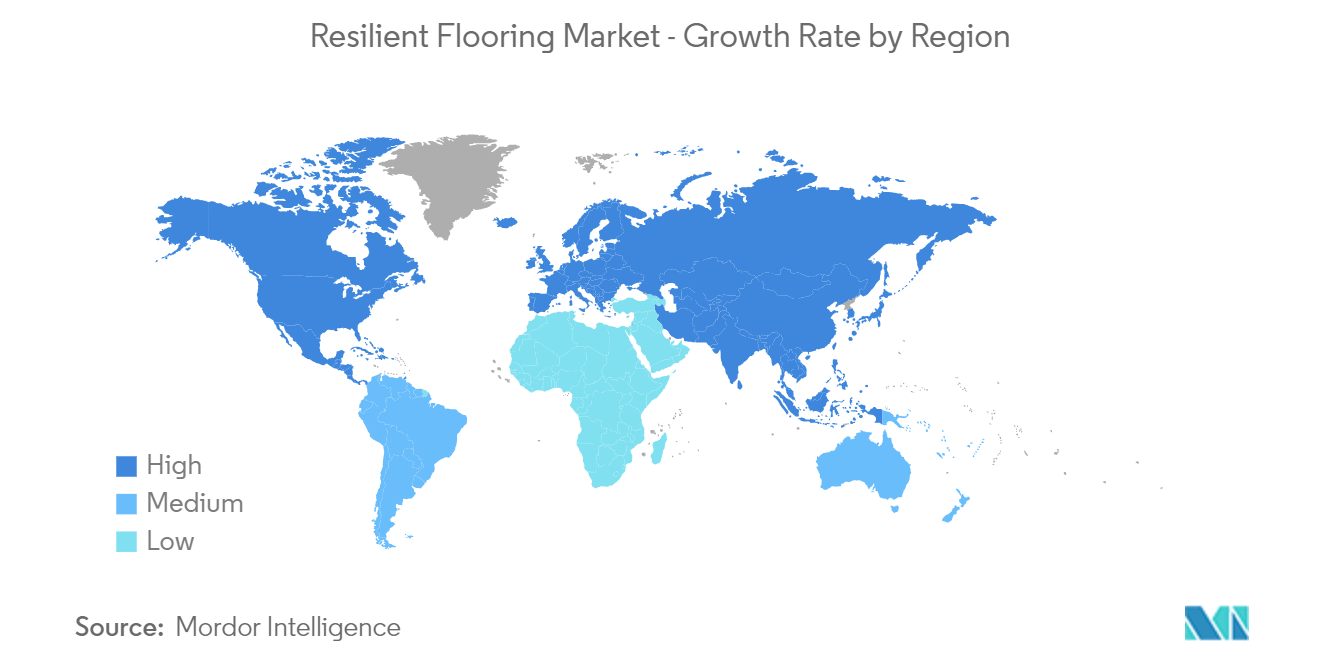
Resilient Flooring Industry Overview
The resilient flooring market is partially consolidated in nature. Some of the major players in the market include (not in any particular order) Beaulieu International Group, Mannington Mills Inc., Mohawk Industries, Shaw Industries Group Inc., and Tarkett.
Resilient Flooring Market Leaders
-
Beaulieu International Group
-
Mannington Mills, Inc.
-
Mohawk Industries
-
Shaw Industries Group, Inc
-
Tarkett
*Disclaimer: Major Players sorted in no particular order
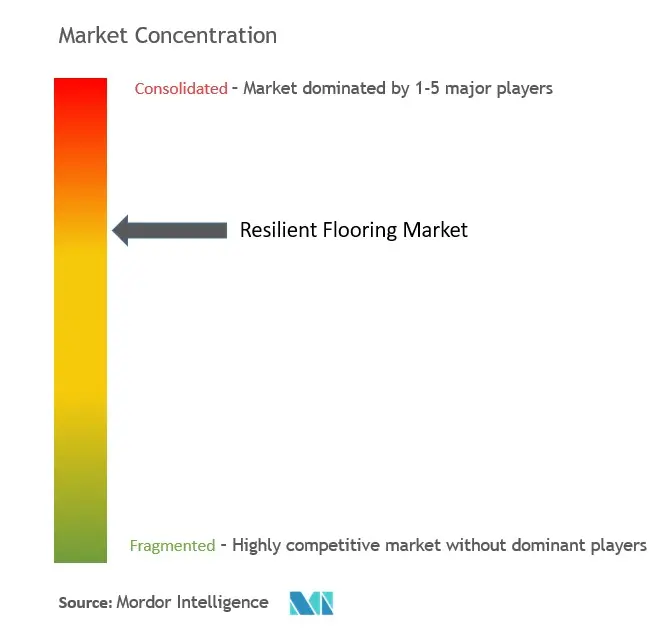
Resilient Flooring Market News
- May 2023: Beaulieu International Group (BIG) completed the acquisition of Signature Floors, a major supplier of residential and commercial flooring solutions in New Zealand and Australia. The acquisition will help Beaulieu International Group to strengthen its position in New Zealand and Australia.
- Jun 2022: Mohawk Industries Inc. entered an agreement with Grupo Industrial Saltillo (GIS) to purchase its Vitromex ceramic tile business. The agreement will help Mohawk Industries Inc. to strengthen its business in Mexico further.
Resilient Flooring Market Report - Table of Contents
1. INTRODUCTION
- 1.1 Study Assumptions
- 1.2 Scope of the Study
2. RESEARCH METHODOLOGY
3. EXECUTIVE SUMMARY
4. MARKET DYNAMICS
-
4.1 Drivers
- 4.1.1 Growing Application of Resilient Flooring at Commercial Places
- 4.1.2 Increasing Demand for Luxury Vinyl Resilient Flooring
- 4.1.3 Other Drivers
-
4.2 Restraints
- 4.2.1 Increasing Concern Over Environmental Impact During Manufacturing of Flooring Materials
- 4.2.2 The Availability of Other Flooring Products
- 4.3 Industry Value Chain Analysis
-
4.4 Porter's Five Forces Analysis
- 4.4.1 Bargaining Power of Suppliers
- 4.4.2 Bargaining Power of Buyers
- 4.4.3 Threat of New Entrants
- 4.4.4 Threat of Substitute Products and Services
- 4.4.5 Degree of Competition
5. MARKET SEGMENTATION (Market Size in Value)
-
5.1 Type
- 5.1.1 Vinyl Flooring
- 5.1.2 Poly Vinyl Chloride (PVC)
- 5.1.3 Fillers
- 5.1.4 Vinyl Sheet Flooring
- 5.1.5 Rubber Flooring
- 5.1.6 Linoleum Flooring
- 5.1.7 Others (Cork Flooring, Vinyl Composite Tiles, etc.)
-
5.2 Application
- 5.2.1 Commercial
- 5.2.2 Residential
- 5.2.3 Institutional
-
5.3 Geography
- 5.3.1 Asia-Pacific
- 5.3.1.1 China
- 5.3.1.2 India
- 5.3.1.3 Japan
- 5.3.1.4 South Korea
- 5.3.1.5 Malaysia
- 5.3.1.6 Thailand
- 5.3.1.7 Indonesia
- 5.3.1.8 Vietnam
- 5.3.1.9 Rest of Asia-Pacific
- 5.3.2 North America
- 5.3.2.1 United States
- 5.3.2.2 Canada
- 5.3.2.3 Mexico
- 5.3.3 Europe
- 5.3.3.1 Germany
- 5.3.3.2 United Kingdom
- 5.3.3.3 Italy
- 5.3.3.4 France
- 5.3.3.5 Spain
- 5.3.3.6 NORDIC
- 5.3.3.7 Turkey
- 5.3.3.8 Russia
- 5.3.3.9 Rest of Europe
- 5.3.4 South America
- 5.3.4.1 Brazil
- 5.3.4.2 Argentina
- 5.3.4.3 Colombia
- 5.3.4.4 Rest of South America
- 5.3.5 Middle East and Africa
- 5.3.5.1 Saudi Arabia
- 5.3.5.2 South Africa
- 5.3.5.3 Nigeria
- 5.3.5.4 Qatar
- 5.3.5.5 Egypt
- 5.3.5.6 UAE
- 5.3.5.7 Rest of Middle East and Africa
6. COMPETITIVE LANDSCAPE
- 6.1 Mergers and Acquisitions, Joint Ventures, Collaborations, and Agreements
- 6.2 Market Share (%)**/Ranking Analysis
- 6.3 Strategies Adopted by Leading Players
-
6.4 Company Profiles
- 6.4.1 AWI Licensing LLC
- 6.4.2 Ardex Endura
- 6.4.3 Beaulieu International Group
- 6.4.4 Forbo Flooring Systems
- 6.4.5 Gerflor.
- 6.4.6 Interface, Inc
- 6.4.7 Mannington Mills, Inc.
- 6.4.8 Milliken & Company
- 6.4.9 Mohawk Industries
- 6.4.10 Nora
- 6.4.11 Polyflor Ltd
- 6.4.12 Shaw Industries Group, Inc
- 6.4.13 Tarkett
- 6.4.14 Unilin
- *List Not Exhaustive
7. MARKET OPPORTUNITIES AND FUTURE TRENDS
- 7.1 Increasing Innovations in Resilient Flooring
- 7.2 Other Opportunities
Resilient Flooring Industry Segmentation
Resilient flooring is usually a mixture of fillers, binders, and colors. Filler materials can include synthetic fibers, ground wood, or limestone, and the material that binds the mixture together is either asphalt or resin.
The Resilient Flooring Market is Segmented by Type (Vinyl Flooring, Poly Vinyl Chloride (PVC), Fillers, Vinyl Sheet Flooring, Rubber Flooring, Linoleum Flooring, and Other Types), Application (Commercial, Residential, and Institutional), and Geography (Asia-Pacific, North America, Europe, South America, and Middle-East and Africa). The Report Offers Market Size and Forecasts for the Market in Value (USD) for all the Above Segments.
| Type | Vinyl Flooring | |
| Poly Vinyl Chloride (PVC) | ||
| Fillers | ||
| Vinyl Sheet Flooring | ||
| Rubber Flooring | ||
| Linoleum Flooring | ||
| Others (Cork Flooring, Vinyl Composite Tiles, etc.) | ||
| Application | Commercial | |
| Residential | ||
| Institutional | ||
| Geography | Asia-Pacific | China |
| India | ||
| Japan | ||
| South Korea | ||
| Malaysia | ||
| Thailand | ||
| Indonesia | ||
| Vietnam | ||
| Rest of Asia-Pacific | ||
| Geography | North America | United States |
| Canada | ||
| Mexico | ||
| Geography | Europe | Germany |
| United Kingdom | ||
| Italy | ||
| France | ||
| Spain | ||
| NORDIC | ||
| Turkey | ||
| Russia | ||
| Rest of Europe | ||
| Geography | South America | Brazil |
| Argentina | ||
| Colombia | ||
| Rest of South America | ||
| Geography | Middle East and Africa | Saudi Arabia |
| South Africa | ||
| Nigeria | ||
| Qatar | ||
| Egypt | ||
| UAE | ||
| Rest of Middle East and Africa |
Resilient Flooring Market Research FAQs
How big is the Resilient Flooring Market?
The Resilient Flooring Market size is expected to reach USD 31.12 billion in 2024 and grow at a CAGR of greater than 8% to reach USD 47.88 billion by 2029.
What is the current Resilient Flooring Market size?
In 2024, the Resilient Flooring Market size is expected to reach USD 31.12 billion.
Who are the key players in Resilient Flooring Market?
Beaulieu International Group, Mannington Mills, Inc., Mohawk Industries, Shaw Industries Group, Inc and Tarkett are the major companies operating in the Resilient Flooring Market.
Which is the fastest growing region in Resilient Flooring Market?
Asia Pacific is estimated to grow at the highest CAGR over the forecast period (2024-2029).
Which region has the biggest share in Resilient Flooring Market?
In 2024, the Asia Pacific accounts for the largest market share in Resilient Flooring Market.
What years does this Resilient Flooring Market cover, and what was the market size in 2023?
In 2023, the Resilient Flooring Market size was estimated at USD 28.63 billion. The report covers the Resilient Flooring Market historical market size for years: 2019, 2020, 2021, 2022 and 2023. The report also forecasts the Resilient Flooring Market size for years: 2024, 2025, 2026, 2027, 2028 and 2029.
Rubber Flooring Industry Report
The Resilient Flooring Market Report provides an in-depth industry analysis, covering various types such as vinyl flooring, poly vinyl chloride (PVC), fillers, vinyl sheet flooring, rubber flooring, linoleum flooring, and other types. The report segments the market by application, including commercial, residential, and institutional uses, and by geography, encompassing Asia-Pacific, North America, Europe, South America, and the Middle-East and Africa.
The report offers a comprehensive market overview, examining market growth and market trends. It includes detailed market segmentation and market value assessments. The industry reports also provide insights into market leaders and market data, giving a clear picture of the current market outlook.
The industry information includes a thorough market forecast, projecting future market growth and market predictions. The report also features an industry outlook, highlighting industry trends and industry statistics that are crucial for understanding the resilient flooring market's dynamics.
Additionally, the report includes a market review and industry research, offering a historical overview and future market forecast outlook. The industry size and industry sales are analyzed to provide a complete picture of the market's performance. For those interested in further details, the report is available as a report PDF, and a sample can be downloaded for free.
In summary, the Resilient Flooring Market Report is an essential resource for understanding market trends, market segmentation, and market value in the resilient flooring industry. It provides a detailed industry analysis, covering market growth, market leaders, and market data, making it a valuable tool for industry research and market predictions.



